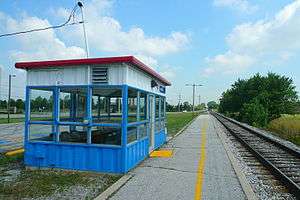Dyer station
Dyer is an Amtrak station in Dyer, Indiana, served by the Cardinal route.
Dyer, IN | |||||||||||||||
|---|---|---|---|---|---|---|---|---|---|---|---|---|---|---|---|
 The old Amtrak shelter station at Dyer before replacement, looking "railroad west" (compass northwest) towards Chicago. | |||||||||||||||
| Location | 913 Sheffield Avenue, Dyer, Indiana | ||||||||||||||
| Coordinates | 41.5154°N 87.5181°W | ||||||||||||||
| Line(s) | CSX Monon Subdivision | ||||||||||||||
| Platforms | 1 side platform | ||||||||||||||
| Tracks | 1 | ||||||||||||||
| Construction | |||||||||||||||
| Disabled access | ADA accessible | ||||||||||||||
| Other information | |||||||||||||||
| Station code | DYE | ||||||||||||||
| History | |||||||||||||||
| Rebuilt | 1986, 2014 | ||||||||||||||
| Traffic | |||||||||||||||
| Passengers (2018) | 3,198[1] | ||||||||||||||
| Services | |||||||||||||||
| |||||||||||||||
| Former services | |||||||||||||||
| |||||||||||||||
Dyer Station was merely a sheltered platform and a little shelter with just seats before a renovation in 2014, which demolished the 1970s era "Amshack" shelter, built a larger station house which was ADA accessible, and repaved the platform and parking lot.[2] It is located near an at-grade crossing of two railroad lines; CSX (formerly the Monon Railroad) and the Elgin, Joliet & Eastern.[3] The original depot stood at the diamond junction itself.[4]
The Northern Indiana Commuter Transportation District (NICTD) has proposed a line to Lowell, Indiana, using Dyer as a stop. However, the station is intended to be south of both the existing station and the CSX/EJ&E crossing at U.S. 30.[5]
Connections
On August 2, 2010, Northwest Indiana Regional Bus Authority revamped the Hammond Transit System into EasyGo Lake Transit. The newly introduced Red Route terminated approximately a mile northeast of the station, at Main/Calumet intersection. Riders could take the Red Route to Munster, Hammond and Chicago's East Side neighborhood. They could also transfer to other EasyGo routes and connect to other towns and cities throughout Lake Country.
Hammond Transit and EasyGo Lake Transit discontinued all service on June 30, 2012.[6]
Notes
- "Amtrak Fact Sheet, FY2018, State of Indiana" (PDF). Amtrak. June 2019. Retrieved 30 December 2019.
- http://www.greatamericanstations.com/Stations/DYE
- Crossing CSX and EJ&E; August 28, 2001 (TrainWeb)
- Longest (2007), 93.
- "West Lake Corridor Study (NICTD)". Archived from the original on 2009-06-07. Retrieved 2010-03-26.
- http://www.rba-nwi.org/index.cfm
References
- Longest, David E. (2007). Railroad Depots of Northern Indiana. Arcadia Publishing. ISBN 0-7385-4131-1.
External links
- Dyer, IN – Amtrak
- Dyer Amtrak Station (USA Rail Guide -- Train Web)
- Dyer (DYE)--Great American Stations (Amtrak)